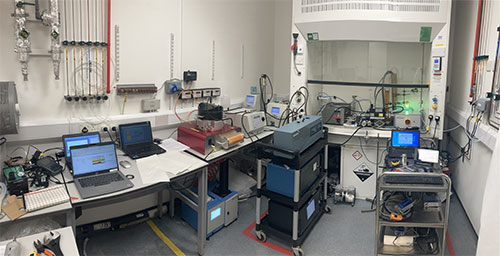Organic components are used to coat soot particles to varying thickness to which in-vitro cellular models are exposed. This reproducible source of synthetic uncoated and coated soot particles was successfully used within the EMPIR AeroTox project to expose various biological respiratory model systems to characterise the effects of this exposure.

Figure 1: Laboratory facility at NPL constructed for EMPIR AeroTox campaign and characterisation of soot generator (miniCAST) and Organic Coating Unit (OCU). Instrumentation used in campaign: Nano Aerosol Chamber In-Vitro Toxicity (NACIVT), Condensation Particle Counter (CPC), Scanning Mobility Particle Sizer (SMPS), Aethalometers AE33 and AE22, Nephelometer and Tapered Element Oscillating Microbalance (TEOM).
Investigating toxicological effects caused by specific airborne pollutants has helped to improve respiratory screening protocols and to develop new techniques, e.g. a high-resolution microscopy method, to obtain greater correlation between in vitro studies and real-world health effects.
Find out more